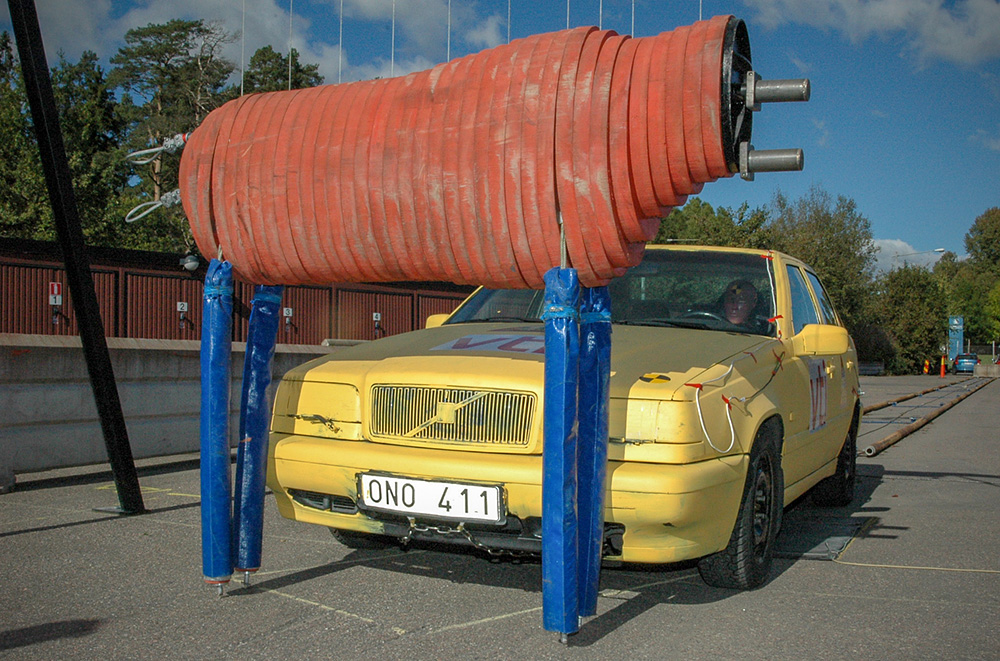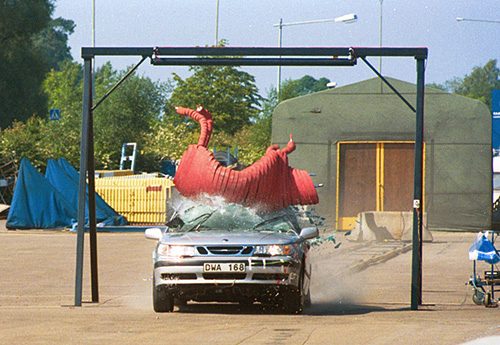Moose mannequin a belated success

It came out of the blue. A 2022 Ig Nobel Prize goes to engineer Magnus Gens of KTH, who developed a crash-test dummy for moose collisions over 20 years ago as part of a master’s thesis. But now the dummy’s designer hopes it can be put to some genuine use.

“People know so little about what happens when a car collides with a large animal. The consequences are truly horrific. The windscreen shatters and the roof is almost completely torn off, as we could show in our tests,” says Magnus Gens, who took his Vehicle Engineering degree at KTH in the early 2000s.
The Ig Nobel Prizes are awarded to research that makes people laugh, but also think. The KTH engineer’s innovation wins the 2022 prize in the Safety Engineering category.
In association with the Swedish National Road and Transport Research Institute/VTI and Saab, as a student Gens developed one of the world’s first crash-test dummies for moose, or elk, collisions. It is built around more than 100 rubber plates, held together by wires and steel tubing.
“At the time, I was surprised the dummy didn’t attract more attention. We made some powerful findings that could have made a big difference.”
Suddenly in the limelight
When Gens found out about the prize, he realised it might attract some attention – but he wasn’t prepared for just how much. His phone rang off the hook for several days, and even the UK’s BBC got in touch for an interview.
“It’s nice, but also a bit weird. It’s something that only happens once in a lifetime. But it also reminded me that the innovation should maybe have made more of an impact from the start.”
Why did it not, do you think?
“Maybe because an accident like this isn’t relevant in that many countries around the world. But I also think that car makers get off far too lightly with the crash tests they currently use.”

Gens says that even minor safety improvements, such as windscreen quality, would make a big difference.
“This kind of accident doesn’t release a vehicle’s airbags. The moose hits the windscreen and the struts above it head on. These safety aspects aren’t covered in standard crash tests.”
Russian roulette
He describes the risks associated with a collision as a kind of Russian roulette. Under certain specific conditions, depending on the car’s size and height and the moose’s position during the accident, the animal’s body hits the ‘bull’s eye’ – and the consequences are devastating.
“My hope is that the prize might generate some new interest regarding safety in accidents involving wildlife. It would mean a lot if the world’s car makers starting talking about and debating the issues again.”
That may in fact already be happening. A few years ago, Spain borrowed the moose dummy for testing. And just recently, a major manufacturer of electric cars contacted Gens’s then supervisor, wanting to see the drawings for the moose mannequin.
For many years now, Magnus Gens has worked in IT development, and as a consultant he’s involved with various companies working on digital challenges. He builds infrastructure, and helps companies work with the latest AI technology in their systems and organisations.
Gens says that receiving the Ig Nobel Prize at the online ceremony held recently at Harvard University was quite an experience. The prize was awarded by one of the joint 2008 Nobel Laureates in Chemistry, and Gens now also has an open invitation to visit Harvard to lecture.
“I intend to go there as soon as all the restrictions have lifted. I’ll talk about the moose dummy – there’s a lot more to talk about.”
Text: Christer Gummeson
